Introduction
This article is the second in a series I’m writing about the benefits of taking an unconcentrated portfolio approach to stock investing. It is about a myth that has developed over the years that states that portfolios that hold a large number of positions (let’s say 50-100) are destined for average market performance. And, as a consequence of that, if an investor wants to achieve significant outperformance, they should concentrate their portfolio on a small number of stocks for which they have the most conviction. I am of the opinion that for the vast majority of individual investors concentration is not the best strategy. In my last article, “Reducing Luck: A Key Benefit Of An Unconcentrated Portfolio” I explained a few of those reasons. In this article, I will directly address a misunderstanding I think many investors have about “diworsification” and concentration.
What does “Diworsification” mean?
Diworsification, I believe, was first coined or popularized by the well-known investor Peter Lynch. But it also has advocates like Warren Buffett, and perhaps its most adamant advocate, Charlie Munger. Because these three very successful investors have been widely read by most individual investors, and are all fantastic investors in their own right, I think many investors become convinced fairly early on, that if they ever decide to move from index investing to individual stock investing, it only makes sense to have a relatively concentrated portfolio. Ideally, this portfolio might only be 3 positions, but probably not more than 20.
There are several parts to this diworsification argument. One is directed at black-swan-like events that are unforeseeable or simply a matter of bad luck that might occur at a scale that could ruin someone’s portfolio. It is these black-swan events that are assumed to be the primary reason for diversification from a statistical standpoint. If that’s the case, then most of the benefits from protection against random negative events come from the first 3 positions in an investor’s portfolio. This is just simple math. If a catastrophic event ever happened to a single business, the loss would be 100%. If an investor owned two businesses, however, then they could have saved 50% more of their wealth if the catastrophic event hit one of them. If they owned 3 businesses, they could have saved an additional 17% of their wealth compared to if they had only owned 2 businesses and 1 was destroyed. If they owned 4 businesses, they would only preserve about 8% more of their wealth if one was destroyed. So, when viewed this way, the benefits of diversification in order to avoid random and unpredictable catastrophes mostly occur with the first three businesses. This is really just a matter of math and I agree with that math as it applies to the premise.
The problem is that this argument assumes the only mistake an investor is likely to make is one where a random event is the most likely cause of a bad investment. In reality, most investors do not start out anywhere close to perfect when it comes to buying businesses. They actually start out pretty horrible in my experience. I covered some of this in my last article, but the truth is investing well is a skill just like any other that has to be developed and improved upon over time. There are no 12-year-old “investing prodigies” as you might find with piano or chess players. So, it’s wrong for an investor to assume that random catastrophic events are the primary cause of concern for investors. They aren’t. The primary cause for concern is that investors haven’t learned how to invest well, yet, and they will either choose bad businesses that don’t perform well, or they will pay far too much for good businesses and not perform well. I think an investing strategy should take this into account. Even with more than 95 years of experience, Munger invested in Alibaba (BABA) three years ago, which was a mistake. Imagine the damage it would have done if he had put 1/3rd of his net worth into that investment. I promise you that if something like this can happen to Munger, then it can happen to you too.
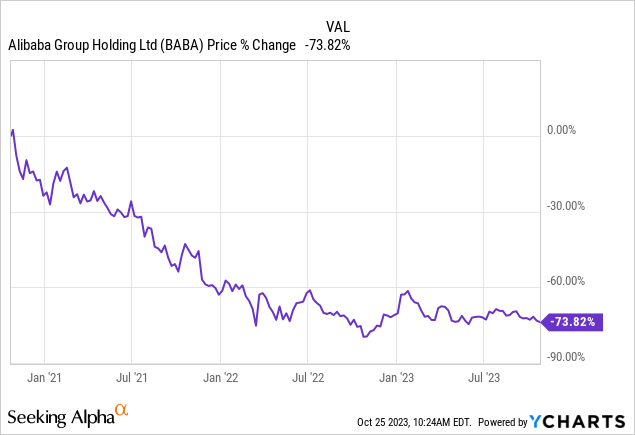
The next part of the diworsification argument is that it is usually unwise to diversify for diversification’s sake. This is the “cutting the flowers and watering the weeds” argument, where, simply because a position has grown larger than average in one’s portfolio, it is cut and rebalanced in order to achieve diversification. And, I mostly agree with the argument that this sort of rebalancing is a bad idea. But I do think there are limits. As I noted in my previous article, for most of my strategies (the ones that do not deal with deep cyclical business) as long as valuations don’t get extreme, I don’t trim my winners for the sake of rebalancing. As long as earnings keep up with the stock price and within some reasonable range, I let stocks grow. I also very rarely add to ‘losers’ unless they are deep cyclicals that really overshoot to the downside. My largest weighted position is about 20x bigger than my smallest, even though they both started out at roughly the same size a few years ago. And if we look deeper than the stock price movement at the earnings of these businesses, the best stock position I currently own had earnings double over the past few years while the worst one saw earnings fall by -70% or so. So, it’s not just the stock price, but also the basic fundamentals that have been winning or losing.
My approach, of equal weighting at the beginning and letting time sort out the winners, but not rebalancing, is very different from placing a big initial bet on a high-conviction stock, or continuing to add to a stock because the stock price has risen and therefore been a “winner”. Yet, for the most part, I also don’t add to “losers”. Over time, winners and losers will work themselves out without assistance from me, the losers will shrink as part of the portfolio and the winners will compound. So, it’s possible to have an unconcentrated portfolio without watering the weeds, or rebalancing for no good reason, and cutting the flowers.
An important part of this is being able to perform some sort of valuation analysis on individual stocks and also being able to watch for business deterioration even if it’s a business that has had a very good long-term run.
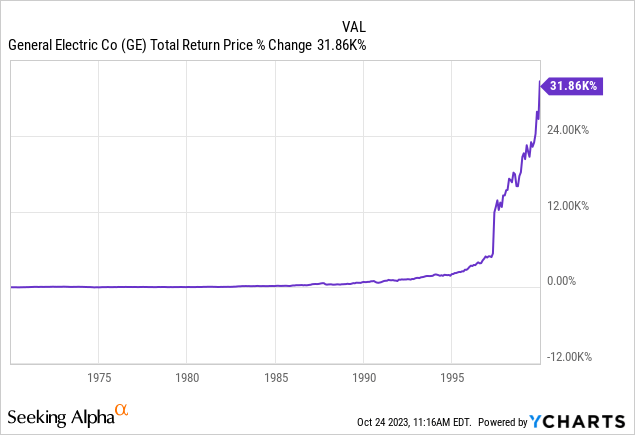
From January 1970 through January 2000 General Electric (GE) rose 31,860%. Investors who happened to be holding this stock had a big winner. If an investor had just let this grow over this time and retired in 2000, it is entirely possible that 90% of their retirement portfolio would have been in a single business. Maybe someone might have even retired early because they were much richer than expected at a younger age. According to someone really attached to Munger’s hardcore philosophy, they should not have sold any GE around the year 2000 regardless of valuation or concentration.
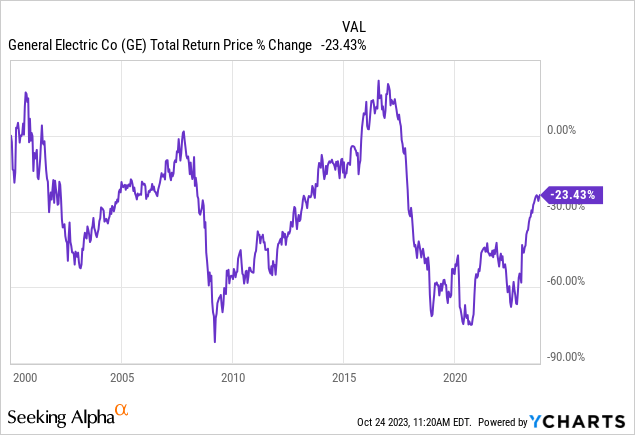
Above are General Electric’s total returns since 2000. An investor who was relying on 90% of their retirement income coming from GE would likely be broke by now. This was arguably one of the top three businesses in America in the year 2000. A huge “winner” over the previous decades. Investors who refused to sell when it was overvalued or had trouble with the business, or who, even worse, kept adding to their “winner” have experienced an unmitigated life disaster.
So, there are limits to letting winners run and never selling for any reason, especially in a concentrated portfolio. For me, even though I let my winners run, that limit for a single position is probably about 1/3 of a portfolio, because, as I showed earlier, beyond that point, there are significant benefits to guarding against random bad luck. Berkshire Hathaway (BRK.B) is the largest single position in many of my accounts, but I would even trim that back if it grew to over 1/3rd of my portfolio.
Can Large Portfolios Outperform?
The idea that a portfolio of 50-100 positions can’t perform better than average is one of the more ridiculous and most easily debunked ideas that stems from the arguments against diversification. First, if having a concentrated portfolio was necessary to perform better than average, how come it is so difficult for money managers to beat the S&P 500 index? It has 500 stocks, yet time and time again, it remains difficult for both individual investors and money managers to consistently perform better than this 500-stock portfolio over extended periods of time. And how has an even more diversified hedge fund like Ray Dalio’s Bridgewater been able to consistently outperform over a long period of time if avoiding concentration is so detrimental to performance?
But the simplest way to debunk this performance myth is with a simple thought experiment. If you took the best-performing 100 stocks of the S&P 500 over any given time period, do you think they would perform similarly or significantly better than the remaining 400? Of course the best 100 would, nearly by definition, perform better than the worst-performing 400! It’s totally ridiculous to think they wouldn’t.
I could perform a lot of research and post 50 or 100 performance charts to prove my case about the statement above, but instead, all we really have to do is compare the QQQ ETF (QQQ) which has about 100 stocks, to the Dow Jones Industrial (DIA) which has 30 to the S&P 500 (SPY), which has about 500. If this theory about diversification beyond 20 stocks is true, then these returns over time for these indices should be about the same.
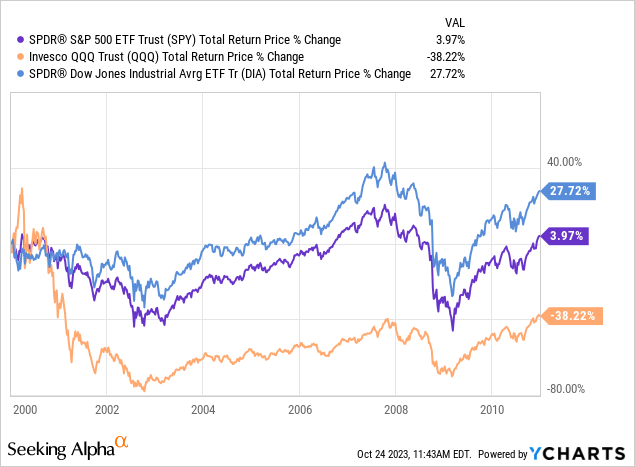
This first chart is from the 11 years from 2000 to 2011. There is a massive separation between the three ETFs, and it doesn’t appear correlated at all with the number of stocks in the portfolios even though there is a significant overlap of stocks between them. If portfolio size was a factor we should expect either them all to trade similarly or QQQ with 100 stocks, to be in the middle of the Dow, with 30, or SPY, with 500. The truth of the matter is there is more than a decade here where SPY with 500 stocks significantly outperformed QQQ with 100.
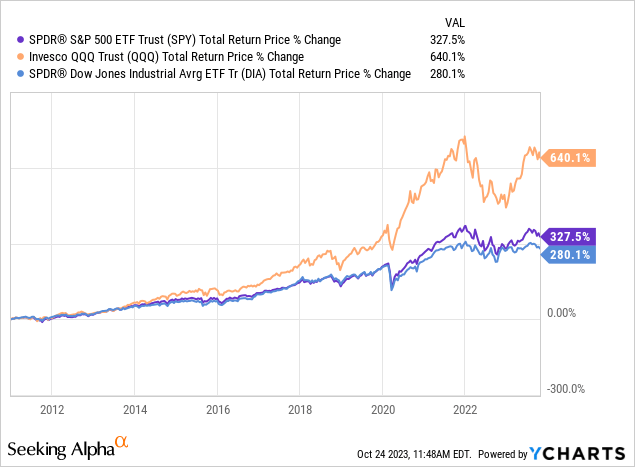
And then, from 2011 through today (another decade-plus time frame) we see even more separation of the 100 stock portfolio from both SPY and DIA. I thought this was supposed to be virtually impossible for a portfolio with 100 stocks! Additionally, QQQ produced something like an 18% CAGR over this time period, which is great in absolute terms as well.
So, we can see right here that it’s possible for a 100-stock portfolio to both perform well over more than a decade and to differentiate itself from average returns. And while the top holdings, Apple (AAPL) and Microsoft (MSFT) are about 10% to 11% of the weighting, they are nowhere near above what I consider the more concerning level of about 30%, when serious concentration risk might call for them to be trimmed for risk management sake.
Conclusion
Having a more concentrated portfolio can amplify returns in either direction, both up and down. However, a concentrated portfolio is not necessary to get above-average returns from a stock portfolio. Good investing is part of a learning process that improves with time and practice. It does not make sense for inexperienced investors to have a concentrated portfolio when they are likely to make significant mistakes in judging the future prospects of businesses and reasonable prices to pay for them. If an investor has a good process, they can fill a 50-100 position portfolio over time that produces better than average long-term returns with less risk and more room to learn from one’s inevitable mistakes. There is no need to fear the “diworsification” boogeyman.
Editor’s Note: This article discusses one or more securities that do not trade on a major U.S. exchange. Please be aware of the risks associated with these stocks.
Read the full article here



